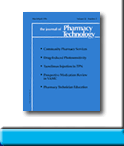 |
 |
Suppository Preparation: Density Factor Determination for Some Over-the-Counter Analgesic Products
Antoine Al-Achi, Sapana Patel, Krishna Cherukuri, and Dinal Gandhi
To request full article click here.
Background: The formulation of analgesic suppositories by the compounding pharmacist may offer an alternative to patients who cannot take medications orally.
Objective: To determine the density factor (DF) for 9 nonprescription nonsteroidal antiinflammatory drugs, aspirin, and acetaminophen for use in compounding suppositories.
Methods: Nine nonprescription analgesic products were purchased from local stores in North Carolina. All products were solid dosage forms (ie, tablets, caplets, or geltabs). The solid units were pulverized with a porcelain mortar and pestle and then incorporated into a cocoa butter base for formulating the suppository. The DF estimation was evaluated according to the Paddock method.
Results: The highest DF value (mean ± SD) among the products tested was for St. Joseph Aspirin (1.45 ± 0.78); the lowest value was for Motrin IB (ibuprofen) (1.06 ± 0.23). Overall, 11.1% (40/360) of all compounded suppositories had some sort of defect. The most often encountered defect was chipping (3.6%; 13/360); the least encountered was sticking to molds (0.83%; 3/360).
CONCLUSIONS: A practical method for preparing compounded suppositories provides a viable alternative for patients who require analgesic medications but cannot take them orally.
J Pharm Technol 2009;25:303-8.
To request full article click here.
|
|
|
||
|

